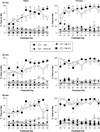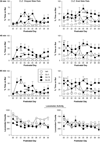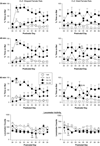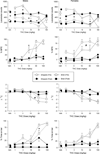To breed or not to breed? Empirical evaluation of drug effects in adolescent rats
- PMID: 19041390
- PMCID: PMC2637202
- DOI: 10.1016/j.ijdevneu.2008.11.002
To breed or not to breed? Empirical evaluation of drug effects in adolescent rats
Abstract
The recent upsurge of research on adolescent rats raises the issue of the extent to which different methods of rodent procurement might affect results. Here, we examined the effects of acute and repeated dosing with two antipsychotics, haloperidol and clozapine, and Delta(9)-tetrahydrocannabinol [Experiments 1 and 2, respectively] in adolescent rats of both sexes that differed in shipping status (i.e., shipped from a commercial breeder at weaning or bred in-house). In each experiment, test drugs produced effects that were characteristic for their respective classes in previous studies with adult rodents. Both haloperidol and clozapine produced catalepsy and haloperidol decreased locomotion in shipped and bred rats of both sexes, with sensitization to haloperidol-induced catalepsy developing with repeated dosing. The most prominent between-status difference in this experiment was greater sensitivity of the shipped rats to haloperidol-induced changes in locomotor activity over a wider dose range, an effect that was especially evident in females. In Experiment 2, vehicle levels of motor activity were decreased in bred rats (which did not occur in Experiment 1), resulting in flattening of the Delta(9)-tetrahydrocannabinol dose-effect curve for this measure in bred rats of each sex. Acutely, Delta(9)-tetrahydrocannabinol produced antinociception, hypothermia and catalepsy in both groups of rats, with tolerance developing after repeated dosing. Status-related differences were sex-dependent. Whereas bred female rats were more sensitive to Delta(9)-tetrahydrocannabinol's antinociceptive effects, shipped male rats were more sensitive to its antinociceptive effects as well as to its hypothermic and cataleptic effects. Together, the results of these descriptive experiments suggest that between-status differences tend to be quantitative rather than qualitative. Further, these results suggest that careful attention to issues related to rodent procurement during adolescence is warranted and may help to account for divergent findings in different labs.
Figures






Similar articles
-
Evaluation of age and sex differences in locomotion and catalepsy during repeated administration of haloperidol and clozapine in adolescent and adult rats.Pharmacol Res. 2008 Sep-Oct;58(3-4):240-6. doi: 10.1016/j.phrs.2008.08.002. Epub 2008 Aug 22. Pharmacol Res. 2008. PMID: 18790058 Free PMC article.
-
Delta-9-tetrahydrocannabinol differently affects striatal c-Fos expression following haloperidol or clozapine administration.Eur J Pharmacol. 2008 Nov 19;598(1-3):16-20. doi: 10.1016/j.ejphar.2008.08.020. Epub 2008 Aug 30. Eur J Pharmacol. 2008. PMID: 18789920
-
Antipsychotic-induced alterations in CB1 receptor-mediated G-protein signaling and in vivo pharmacology in rats.Neuropharmacology. 2008 Dec;55(7):1183-90. doi: 10.1016/j.neuropharm.2008.07.026. Epub 2008 Jul 30. Neuropharmacology. 2008. PMID: 18708079 Free PMC article.
-
Sex differences in Δ(9)-tetrahydrocannabinol metabolism and in vivo pharmacology following acute and repeated dosing in adolescent rats.Neurosci Lett. 2014 Jul 25;576:51-5. doi: 10.1016/j.neulet.2014.05.057. Epub 2014 Jun 5. Neurosci Lett. 2014. PMID: 24909619 Free PMC article.
-
Pharmacological effects of acute and repeated administration of Delta(9)-tetrahydrocannabinol in adolescent and adult rats.J Pharmacol Exp Ther. 2007 Mar;320(3):1097-105. doi: 10.1124/jpet.106.108126. Epub 2006 Dec 15. J Pharmacol Exp Ther. 2007. PMID: 17172531
Cited by
-
Acute stress imposed during adolescence has minimal effects on hypothalamic-pituitary-adrenal (HPA) axis sensitivity in adulthood in female Sprague Dawley rats.Physiol Behav. 2020 Jan 1;213:112707. doi: 10.1016/j.physbeh.2019.112707. Epub 2019 Oct 18. Physiol Behav. 2020. PMID: 31634523 Free PMC article.
-
Age-dependent effects of repeated amphetamine exposure on working memory in rats.Behav Brain Res. 2013 Apr 1;242:84-94. doi: 10.1016/j.bbr.2012.12.044. Epub 2013 Jan 3. Behav Brain Res. 2013. PMID: 23291159 Free PMC article.
-
Stress and nicotine during adolescence disrupts adult hippocampal-dependent learning and alters stress reactivity.Addict Biol. 2020 May;25(3):e12769. doi: 10.1111/adb.12769. Epub 2019 May 16. Addict Biol. 2020. PMID: 31099135 Free PMC article.
-
Effects of self-administered cocaine in adolescent and adult male rats on orbitofrontal cortex-related neurocognitive functioning.Psychopharmacology (Berl). 2009 Sep;206(1):61-71. doi: 10.1007/s00213-009-1579-3. Epub 2009 Jun 10. Psychopharmacology (Berl). 2009. PMID: 19513699 Free PMC article.
-
Effects of adolescent alcohol exposure via oral gavage on adult alcohol drinking and co-use of alcohol and nicotine in Sprague Dawley rats.Drug Alcohol Depend. 2022 Mar 1;232:109298. doi: 10.1016/j.drugalcdep.2022.109298. Epub 2022 Jan 11. Drug Alcohol Depend. 2022. PMID: 35038606 Free PMC article.
References
-
- Adriani W, Laviola G. Windows of vulnerability to psychopathology and therapeutic strategy in the adolescent rodent model. Behav. Pharmacol. 2004;15:341–352. - PubMed
-
- Antoniou K, Papathanasiou G, Papalexi E, Hyphantis T, Nomikos GG, Spyraki C, Papadopoulou-Daifoti Z. Individual responses to novelty are associated with differences in behavioral and neurochemical profiles. Behav. Brain Res. 2008;187:462–472. - PubMed
-
- Bardin L, Kleven MS, Barret-Grevoz C, Depoortere R, Newman-Tancredi A. Antipsychotic-like vs. cataleptogenic actions in mice of novel antipsychotics having D2 antagonist and 5-HT1A agonist properties. Neuropsychopharmacology. 2006;31:1869–1879. - PubMed
-
- Bass CE, Martin BR. Time course for the induction and maintenance of tolerance to Delta(9)-tetrahydrocannabinol in mice. Drug Alcohol Depend. 2000;60:113–119. - PubMed
-
- Bean-Knudsen DE, Wagner JE. Effect of shipping stress on clincopathologic indicators in F344/N rats. Am. J. Vet. Res. 1987;48:306–308. - PubMed
Publication types
MeSH terms
Substances
Grants and funding
LinkOut - more resources
Full Text Sources
Medical

